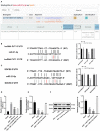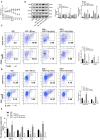Mechanisms of M2 Macrophage-Derived Exosomal Long Non-coding RNA PVT1 in Regulating Th17 Cell Response in Experimental Autoimmune Encephalomyelitisa
- PMID: 33013847
- PMCID: PMC7500097
- DOI: 10.3389/fimmu.2020.01934
Mechanisms of M2 Macrophage-Derived Exosomal Long Non-coding RNA PVT1 in Regulating Th17 Cell Response in Experimental Autoimmune Encephalomyelitisa
Retraction in
-
Retraction: Mechanisms of M2 Macrophage-Derived Exosomal Long Non-coding RNA PVT1 in Regulating Th17 Cell Response in Experimental Autoimmune Encephalomyelitis.Front Immunol. 2021 Sep 24;12:773900. doi: 10.3389/fimmu.2021.773900. eCollection 2021. Front Immunol. 2021. PMID: 34630443 Free PMC article.
Abstract
Long non-coding RNA (lncRNA) is pivotal for multiple sclerosis (MS), but the potential mechanism of lncRNA PVT1 in MS animal model, experimental autoimmune encephalomyelitis (EAE) still remains unclear. In this study, macrophages were firstly isolated and induced to polarize into M2 macrophages. M2 macrophage-derived exosomes (M2-exos) were extracted and identified, and EAE mouse model was established and treated with M2-exos. The effect of M2-exos on EAE mice was evaluated by clinical scores. The proportion of Treg and Th17 cells in spinal cord cells and splenocytes, and levels of inflammatory factors were measured. The targeting relationships among PVT1, miR-21-5p, and SOCS5 were verified. The expression of JAKs/STAT3 pathway-related proteins was measured. After M2-exo treatment, the clinical score of EAE mice decreased, and demyelination and inflammatory infiltration improved; Th17 cells decreased, Treg cells increased, and the levels of inflammatory factors decreased significantly. SOCS5 and PVT1 were downregulated and miR-21-5p was upregulated in EAE mice. PVT1 could sponge miR-21-5p to regulate SOCS5. SOCS5 alleviated EAE symptoms by repressing the JAKs/STAT3 pathway. Together, M2-exos-carried lncRNA PVT1 sponged miR-21-5p to upregulate SOCS5 and inactivate the JAKs/STAT3 pathway, thus reducing inflammation and protecting EAE mice. This study may offer novel treatments for MS.
Keywords: M2 macrophages; SOCS5; exosomes; experimental autoimmune encephalomyelitis; long non-coding RNA PVT1; microRNA-21-5p.
Copyright © 2020 Wu, Xia, Li, Kang, Fang and Huang.
Figures






Similar articles
-
Exosomes with membrane-associated TGF-β1 from gene-modified dendritic cells inhibit murine EAE independently of MHC restriction.Eur J Immunol. 2013 Sep;43(9):2461-72. doi: 10.1002/eji.201243295. Epub 2013 Jun 21. Eur J Immunol. 2013. PMID: 23716181
-
Exosomes with FOXP3 from gene-modified dendritic cells ameliorate the development of EAE by regulating the balance of Th/Treg.Int J Med Sci. 2022 Jul 11;19(8):1265-1274. doi: 10.7150/ijms.72655. eCollection 2022. Int J Med Sci. 2022. PMID: 35928722 Free PMC article.
-
M1 Macrophage-Derived Exosome LncRNA PVT1 Promotes Inflammation and Pyroptosis of Vascular Smooth Muscle Cells in Abdominal Aortic Aneurysm by Inhibiting miR-186-5p and Regulating HMGB1.Cardiovasc Toxicol. 2024 Mar;24(3):302-320. doi: 10.1007/s12012-024-09838-5. Epub 2024 Mar 7. Cardiovasc Toxicol. 2024. PMID: 38453799 Free PMC article.
-
1,25-dihydroxyvitamin D3 -induced dendritic cells suppress experimental autoimmune encephalomyelitis by increasing proportions of the regulatory lymphocytes and reducing T helper type 1 and type 17 cells.Immunology. 2017 Nov;152(3):414-424. doi: 10.1111/imm.12776. Epub 2017 Jul 10. Immunology. 2017. PMID: 28617989 Free PMC article.
-
Oxidative Stress and Inflammation in Cardiovascular Diseases and Cancer: Role of Non-coding RNAs.Yale J Biol Med. 2022 Mar 31;95(1):129-152. eCollection 2022 Mar. Yale J Biol Med. 2022. PMID: 35370493 Free PMC article. Review.
Cited by
-
M2 macrophage-derived extracellular vesicles facilitate CD8+T cell exhaustion in hepatocellular carcinoma via the miR-21-5p/YOD1/YAP/β-catenin pathway.Cell Death Discov. 2021 Jul 16;7(1):182. doi: 10.1038/s41420-021-00556-3. Cell Death Discov. 2021. PMID: 34282135 Free PMC article.
-
Innovative Diagnosis and Therapeutic Modalities: Engineered Exosomes in Autoimmune Disease.Int J Nanomedicine. 2024 May 1;19:3943-3956. doi: 10.2147/IJN.S452184. eCollection 2024. Int J Nanomedicine. 2024. PMID: 38708179 Free PMC article. Review.
-
Competing Endogenous RNA Networks as Biomarkers in Neurodegenerative Diseases.Int J Mol Sci. 2020 Dec 16;21(24):9582. doi: 10.3390/ijms21249582. Int J Mol Sci. 2020. PMID: 33339180 Free PMC article. Review.
-
Development and validation of an inflammatory response-related gene and clinical factor-based signature for predicting prognosis in gastric cancer.J Gastrointest Oncol. 2023 Apr 29;14(2):599-616. doi: 10.21037/jgo-23-128. J Gastrointest Oncol. 2023. PMID: 37201041 Free PMC article.
-
Antinociceptive effects of macrophage-derived extracellular vesicles by carrying microRNA-216a.Am J Transl Res. 2021 Apr 15;13(4):1971-1989. eCollection 2021. Am J Transl Res. 2021. PMID: 34017370 Free PMC article.
References
Publication types
MeSH terms
Substances
LinkOut - more resources
Full Text Sources
Miscellaneous

